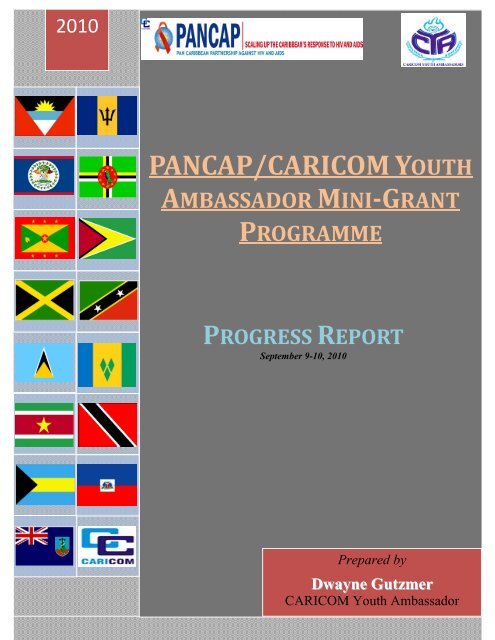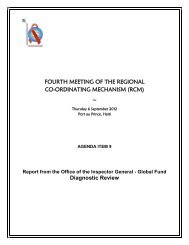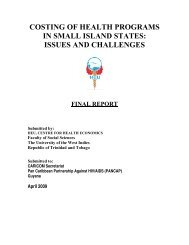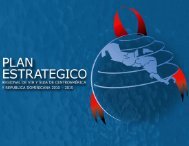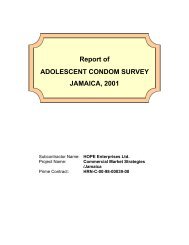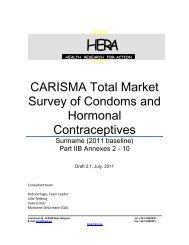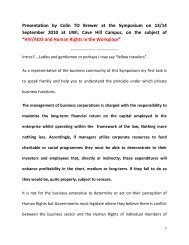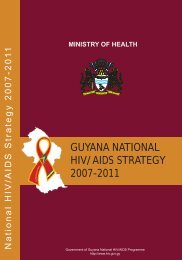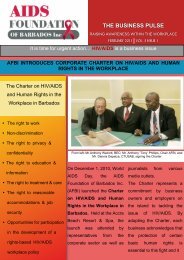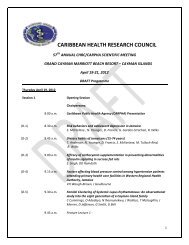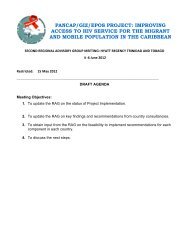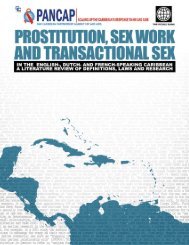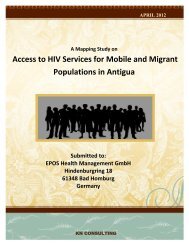PANCAP/CARICOM Youth Ambassador Mini-Grant Programme
PANCAP/CARICOM Youth Ambassador Mini-Grant Programme
PANCAP/CARICOM Youth Ambassador Mini-Grant Programme
You also want an ePaper? Increase the reach of your titles
YUMPU automatically turns print PDFs into web optimized ePapers that Google loves.
2010<strong>PANCAP</strong>/<strong>CARICOM</strong> YOUTHAMBASSADOR MINI-GRANTPROGRAMMEPROGRESS REPORTSeptember 9-10, 2010<strong>PANCAP</strong>/CYA <strong>Mini</strong>-<strong>Grant</strong> <strong>Programme</strong> Progress Report 2010Kamesha Turner[Type Prepared the company by name]5/30/2008Dwayne Gutzmer<strong>CARICOM</strong> <strong>Youth</strong> <strong>Ambassador</strong>Prepared by: Dwayne Gutzmer Page 1
BACKGROUND & INTRODUCTIONThe focus of this paper is to provide report on work undertaken by the <strong>CARICOM</strong> <strong>Youth</strong><strong>Ambassador</strong> <strong>Programme</strong> (CYAP) and youth networks on the final leg of the <strong>CARICOM</strong> /<strong>PANCAP</strong> <strong>Mini</strong> <strong>Grant</strong> <strong>Programme</strong>.The <strong>CARICOM</strong> <strong>Youth</strong> <strong>Ambassador</strong> <strong>Programme</strong> (CYAP) is the Community’s mechanism foryouth leadership development and participation with reference to regional integration anddevelopment. CYAs in 18 <strong>CARICOM</strong> countries perform a dual role, addressing youth issues atthe national level within a regional strategic framework, as well as bringing national issues to theattention of the Region’s policy makers and planners.The <strong>Mini</strong> <strong>Grant</strong> <strong>Programme</strong> (MGP) is a sub-component of the Pan Caribbean Partnership againstHIV and AIDS (<strong>PANCAP</strong>) Regional Project, funded by the World Bank and implemented by the<strong>CARICOM</strong> <strong>Youth</strong> <strong>Ambassador</strong> <strong>Programme</strong>. The MGP aims to create an enabling environmentfor a reduced incidence of HIV/AIDS among persons aged 15 – 24 in disadvantagedcommunities by building leadership capacity of <strong>Youth</strong> organisations/NGOs/ CBOs; facilitatingyouth participation in the development, implementation and management of youth-led HI/AIDSprogrammes; forming youth-adult partnerships, strategic alliances and networks; and utilisingindigenous human, material and other resources.RECENT YOUTH LED HIV AND AIDS INITIATIVESThe Pancap <strong>Mini</strong> <strong>Grant</strong> <strong>Programme</strong> from inception has placed youth at the forefront of planning,coordination and execution of the programme. The programme has developed a cadre of youthtrainers, skilled in facilitation, project design and development and proposal writing. TheRegional <strong>Youth</strong> Technical Resource Network (RYTRN) is a valuable asset to agencies and theSecretariat for future programmes and projects targeting youth.The <strong>Mini</strong> <strong>Grant</strong> programme successful demonstrated the effectiveness and importance of youthto youth interventions to communicate, interact and sensitise youth on issues impacting theirlives. The teams conducted focus groups, house to house visit, community activities andexplored alternative methodologies using sports and culture to mobilise and engage youth.SNAPSHOT OF PR OJE CT S FUNDE DThe allocation of US 75,000 from <strong>PANCAP</strong> allowed the participation of 5 countries (TheBahamas, Belize, Jamaica, St. Kitts & Nevis and Suriname) in the 2010 final round of the<strong>PANCAP</strong>/CYA <strong>Mini</strong> <strong>Grant</strong>s <strong>Programme</strong> and formed the main HIV and AIDS component of theprogramme.The Secretariat, in collaboration with the CYAs and youth networks in five (5) countrieslaunched the programme in January 2010. An orientation and project development workshop forpre-selected organizations and <strong>Mini</strong>stry of <strong>Youth</strong> personnel was held in January 2010. Theworkshop outputs included training of the participants, draft project proposals and a refinedadministrative framework for the 2010 MGP.<strong>PANCAP</strong>/CYA <strong>Mini</strong>-<strong>Grant</strong> <strong>Programme</strong> Progress Report 2010Prepared by: Dwayne Gutzmer Page 2
Following the workshop the participant finalised projects and budgets in consultation withcommunity members, CYAs, <strong>Mini</strong>stry and National AIDS <strong>Programme</strong> officials, Regional <strong>Youth</strong>Technical Resource Network (RYTRN) members and other strategic alliances. <strong>Grant</strong> awardletters were issued to the <strong>Mini</strong>stry with responsibility for <strong>Youth</strong> Affairs requesting commitmentand local support for the programme. Simultaneously, the <strong>CARICOM</strong> Secretariat convenedorientation session to clarify purpose, objectives, implementation strategy & administrativearrangements for the project for the project team along with representatives of the Department of<strong>Youth</strong>, CYAs and other stakeholders.SUMMARY OF PR OJECTS:THE BAHAMAS: Under the guidance of Mr. Keith Kemp, the <strong>Youth</strong> <strong>Ambassador</strong>s for PositiveLiving in the Bahamas organised the 2010 Fox Hill Female Empowerment Seminar, a FocusGroup Discussion, a Condom Distribution Session as well as a “<strong>Youth</strong> Fest”. The seminarwas broken down into four sessions which are as follows;Session One - Teen Dating and ViolenceFacilitator: Ins. Sandra MillerSession ObjectivesPoints CoveredA. To have participants gain knowledge of the dangers of teen a) What is datingdating in the Bahamasb) Group DatingB. To educate participants on how to safe guard themselves when c) Pre-marital sexgoing on a dated) PromiscuityC. To expose young females to the violence that can occur during e) The importance of knowing Your Partnerteen datingf) Violence and Teen DatingD. To educated participants on the recommended methods of g) Domestic violencedatingh) Recommended methods of datingSession Two - AIDS 101 and STI 101Facilitator: Nurse RobertsSession ObjectivesPoints CoveredA. To promote the awareness of HIV & AIDSa) Definition of HIVB. To provide insight on the differences between HIV and AIDS b) Definition of AIDSC. To educate persons on the modes of HIV and STI’s transmission c) Difference between HIV and AIDSD. To enhance the knowledge of prevention educationd) Transmission of HIVe) Sexually Transmitted Infectionsf) Modes of PreventionSession Three - All My Single LadiesFacilitator: Rev. Diana FrancisSession ObjectivesPoints CoveredA. To explain the disadvantages and advantages of being a youngfemaleB. To demonstrate to females the importance of being singleC. To educate young females on how to prepare themselves for apartner while being singleD. To show young females how to develop themselvesSession Four - I Am SpecialSession ObjectivesA. To help females understand the importance of self worth andrespecta) Biography Sketchb) Vulnerabilityc) Peer Pressured) Public Scrutinye) Substance Abusef) Teenage Pregnancyg) Dependency on Menh) Love Deprivationi) Develop a Relationship with GodFacilitator: Mrs. Lisa Paul-AdderleyPoints Covereda) Self Esteemb) Female Empowermentc) Developing one’ self<strong>PANCAP</strong>/CYA <strong>Mini</strong>-<strong>Grant</strong> <strong>Programme</strong> Progress Report 2010Prepared by: Dwayne Gutzmer Page 3
BELIZE: The group Friends in Partnership Reaching Out (FIPRO), organised a number ofactivities which was aimed at collectively sensitizing at least 150 residents between the ages of15 and 29 in the Lakeland and Rivas Estates communities about HIV and AIDS prevention,encourage youth between the ages of 15 and 29 in the Lakeland and Rivas Area in consistentcondom usage as well as promote AIDS education and prevention.The activities included;Behaviour Change and Communication Workshop - A three day workshop that looked at; Stigma & Discrimination, Importance of Testing & Where, STI/STD, Difference between HIV and AIDS, Condom Demonstration, Risky Sexual BehaviourHouse to House Visit - Members shared the information of HIV and AIDS, give an overviewof the project that the group is doing and also distribute pamphlets and condoms.Community members also pass on whatever knowledge of HIV and other community issueto FIPRO membersMovie Night - The movie that was shown is titled, “Precious” and was about an unattractiveyoung female whose mother was abusive. The young girl in the movie survived being raped,was a young mother of two children and was also HIV positive. Despite what she had beenthrough, she still look at life positively.The whole scope of the workshop was to let youths try to change their risky behaviour andprotect themselves. The twenty one (21) participants were also informed of the presentinformation on HIV and AIDS, treatments, stigma and discrimination and where to get tested.All the participants agreed to share the knowledge that they have attained with their peers andhas expressed gratitude for this workshop and urged us to provide more activities like these foryouths of all ages and walks of life.<strong>PANCAP</strong>/CYA <strong>Mini</strong>-<strong>Grant</strong> <strong>Programme</strong> Progress Report 2010Prepared by: Dwayne Gutzmer Page 4
JAMAICA: The Eastern Peace Centre was the implementing agency which facilitated theproject dubbed “Preserve Equality, Support Persons Living with HIV (PLHIV)” which sought todevelop guidelines that would provide a more supportive living environment for PLHIV in theMountain View and Rockfort communities.Additionally the project sensitize 20 community leaders and 700 in and out of school youthbetween the ages of 15-29 within the communities of Mountain View and Rockfort on HIV andAIDS prevention, stigmatization and discrimination.Developing guidelines and document the perspectives of the community people as itrelates to PLHIV: Six (6) focus group discussions were conducted at the Eastern Peaceand Justice Centre.Peer education training: Forty (40) young persons trained to become peer educators.These youngsters were selected from the Burgher Progressive <strong>Youth</strong> Club the RockfortCultural Group.Sensitization on HIV issues 700 youth in and out of school: Three Hundred (300)students from ten (10) High and Junior High Schools have received sensitization andinformation on HIV issues. Over 400 out of school and unattached youth were sensitizedthrough a number of medium such as on the corner drama sessions, on the cornerreasoning sessions and dancehall interventions.Training of community leaders: Twenty (20) community leaders have been sensitizedon HIV issues and some of these community leaders are a part of the group that areconducting he on the corner drama sessions. These sessions largely focus on HIVpreventions, myths and facts, Transactional sexual activities and Positive parentingCommunity Sensitization: To further sensitize the community to the effect of HIV andAIDS, four community meetings were held. These meetings had 129 participantscollectively and were held in the following communities;Community Date # of ParticipantsPoker Flats March 13, 2010 31Norman Gardens March 18, 2010 35Burgher March 25, 2010 34Johnson Town April 8, 2010 29<strong>PANCAP</strong>/CYA <strong>Mini</strong>-<strong>Grant</strong> <strong>Programme</strong> Progress Report 2010Prepared by: Dwayne Gutzmer Page 5
St. KITTS & NEVIS: The projects “Know It, Share It, Live It” and “(N.E.S.T.) Networking toEmpower, Support & Transform” were the two projects implemented in St. Kitts and Nevis.The goal of the “Know It, Share It, Live It” project is to use theatre as a tool to reduce HIV andother sexually transmitted infections among young people ages of 15-19 while the “(N.E.S.T.)Networking to Empower, Support & Transform” project looked at establishing a support groupof informed and empowered young men, who are able to make realistic decisions, which arerelevant to their lives, about practicing and maintaining safe sex. They are in turn supported inthis decision by their peers. The goal is for safer sex to become the mutually accepted norm.Combined, the projects achieved the following; Distributed 975 flyers/brochures about HIV/AIDS to youth and their families during acommunity walk through at which information was given out to youth and brief informalinterviews done about HIV/AIDS. Hosted a HIV/AIDS Knowledge Testing Quiz Competition Constructed & Installed equipment for Kiddies Play Area - swing, slide and monkey bar,etc. Produced a 20 minute Drama Script on stigma and discrimination Trained 10 dance trainers in incorporating HIV/AIDS messages in their art form Support Group of 22 young MSMs between the ages of 16 - 22 established Support services provided for young MSMs ages 16 -22 – participants have been providedwith condoms, informational materials and other related services. Counseling andHIV/AIDS testing are also being organized alongside psycho-social support services. 10 Peer Educators trained from youth MSM community Conducted an educational and motivational seminar to look on issues affecting MSMs inSt. Kitts Care and Share Social hosted for young MSM’s to invite their partners and other MSM’sin their age group Information distributed to young MSMs Held a Focus Group Discussion<strong>PANCAP</strong>/CYA <strong>Mini</strong>-<strong>Grant</strong> <strong>Programme</strong> Progress Report 2010Prepared by: Dwayne Gutzmer Page 6
SURINAME - Stichting Jongeren van Flora en Omgeving (SJOFLO) in Suriname spearheadedthe implementation “HIV Prevention through <strong>Youth</strong> from Flora and surroundings by Sport,Edutainment and sustainability activities”. The goal of assisting in the reduction of HIV andother sexually transmitted infections among young people at the aged of 15-29 in Flora andsurrounding community was achieved through; Increasing the capacity of at least 25 young sports and drama leaders in planning andimplement HIV and AIDS sensitization activities. Increasing HIV knowledge and skills among 300 young people in Flora andsurroundings through sports and edutainment strategies. Raising awareness of youth, HIV and AIDS issues in the community throughcommemorative items. Information sessions and sustainability activities as painting a mural and etc.The group development an HIV and AIDS memorial in the form of an HIV and AIDS clock,centrally located in a healthy lifestyle park. A mural on the wall of the community complexreflects the views, feelings and concerns of young people in the community on HIV and AIDS.Quoting the young people, the wall will be a reminder of the daily risk and challenges they faceand methods to avoid risky behaviours.Flora is one of the Commnities where the <strong>Mini</strong> grant programme was originally implemented.The SJOFLO group noted the change in the lifestyles of youth in the area and attributed this tonot only the increase in access to HIV and AIDS information, but the execution of the project inthe community. This directly impacted the lives of many young persons, both coordinators andbeneficiaries of the programme.<strong>PANCAP</strong>/CYA <strong>Mini</strong>-<strong>Grant</strong> <strong>Programme</strong> Progress Report 2010Prepared by: Dwayne Gutzmer Page 7
Pre/Post TestThe test included 23 participants from The Bahamas who answered both pre-post tests.Questions% Pre testansweredCorrectly% Post TestansweredCorrectly1. Some STIs are curable, but there is no cure for HIV 47.8 91.32. You can recognize a person infected with HIV/AIDS by looking at him/her 8.7 91.33. HIV is present in high concentrations in semen, vaginal fluids and blood 56.5 100.04. One can get HIV if he/she has sex without a condom, even if it is the first time 52.2 100.05. One can get HIV by hugging or touching a person who has HIV or AIDS 52.2 100.06. A person can get HIV by giving (donating) blood 13.0 82.67. The more sexual partners a person has, the greater is the chance of gettinginfected with HIV or another sexually transmitted infection 60.9 100.08. People, who choose only healthy looking partners, won’t be infected with HIV 69.6 69.69. There is no vaccine to prevent a person from contracting HIV/AIDS 87.0 87.010. Condoms protect a person from HIV and STIs if they are used correctly eachtime one has sex 65.2 87.011. A condom can be safely reused 60.9 91.312. A good rule to protect oneself from HIV and STIs is, ‘no sex’ 69.6 100.013. Not to allow a person with HIV to attend school is an example ofdiscrimination 39.1 100.014. A person can get HIV infection from living with a person who has HIV orAIDS 65.2 78.315. HIV can be passed from an infected mother to her unborn child 47.8 78.316. You can get HIV from sharing unsterilized needles for injecting drugs,tattooing and ear piercing 56.5 100.017. The birth control pill protects from HIV or STI 73.9 95.718. There is no way to find out if you are infected with HIV 47.8 95.719. There is no difference between HIV, Sexually Transmitted Infections andAIDS 43.5 95.720. Being non-passionate to a person with AIDS is dangerous because there is agood chance you will become infected with HIV 39.1 73.921. You can get HIV from toilet seats52.2 87.022. You can get HIV from wearing clothes that have been worn by a person withHIV/AIDS 47.8 91.323. A person who has a sexually transmitted infection (STI) is at a greater risk ofgetting HIV/AIDS 52.2 73.924. It is necessary for adolescent boys and girls to have knowledge regardingsexuality including sexual intercourse 52.2 100.025. STIs can be cured if the man with STI has sex with a virgin girl 60.9 95.7Based on results given the organisers summarized the following: These females received basic knowledge on HIV and AIDS It was quite evident that the knowledge and awareness of HIV and AIDS wereenhanced<strong>PANCAP</strong>/CYA <strong>Mini</strong>-<strong>Grant</strong> <strong>Programme</strong> Progress Report 2010Prepared by: Dwayne Gutzmer Page 8
PICTUR ES<strong>PANCAP</strong>/CYA <strong>Mini</strong>-<strong>Grant</strong> <strong>Programme</strong> Progress Report 2010Prepared by: Dwayne Gutzmer Page 9
Recommendation and Conclusion• Further training of the CYAs and the (Regional <strong>Youth</strong> Technical Resource Network)RYTRN• Strengthen the mechanism through which funds are sent from the Secretariat to theimplementing team to avoid project delays• Continued follow up, dialogue and engagement with persons who committed themselvesto assist or contribute to various/projects activities.• Increase the level of funding to improve the levels of participation, implementation andsuccess of projects/activities.• Revisit the timelines given for the conception, development and implementation ofprojects/activities to ensure maximum benefits.• Strengthen the monitoring and evaluation components of projects / activities so as toadequately assess the impact that the initiatives have had on the participants / community.• Continue to align projects/activities with the Findings of the CCYD Report and othersimilar reports and studiesThe CYAs who has participated in the programme thus far has benefited tremendously from theknowledge and experience gained. The CYAP views the challenges faced throughout theprogramme as lessons learnt and will no doubt draw on these experiences to ensure the smoothcompletion/implementation of future projects/activitiesWe remain confident that the successful implementation and possible replication of thesestrategies in other territories is of paramount importance if we want to ensure that the HIV/AIDsrate continue to trend downwards. As CYAs we will continue to conceptualize, develop andimplement non-traditional, creative and dynamic youth friendly strategies to aid in the combatingof this global epidemic.The lives and future of millions of young across the region are depends on these and futureinitiatives. As pointed out at the XVII International Aid Conference held in Vienna, July 2010,“For every two people who get treatment, 5 others get infected!!” We MUST continue to worktogether as we seek to find a new and creative ways to stem this alarming and untenable trend.<strong>PANCAP</strong>/CYA <strong>Mini</strong>-<strong>Grant</strong> <strong>Programme</strong> Progress Report 2010Prepared by: Dwayne Gutzmer Page 10


